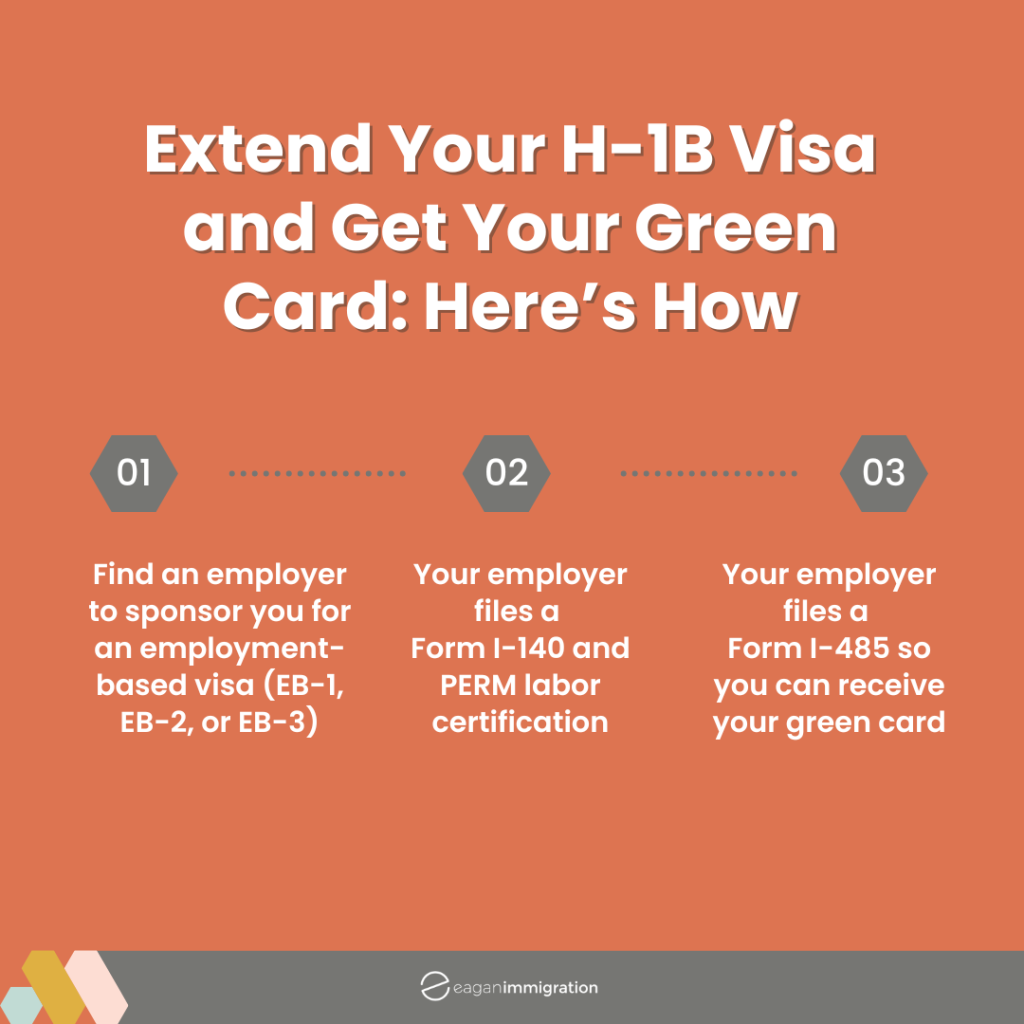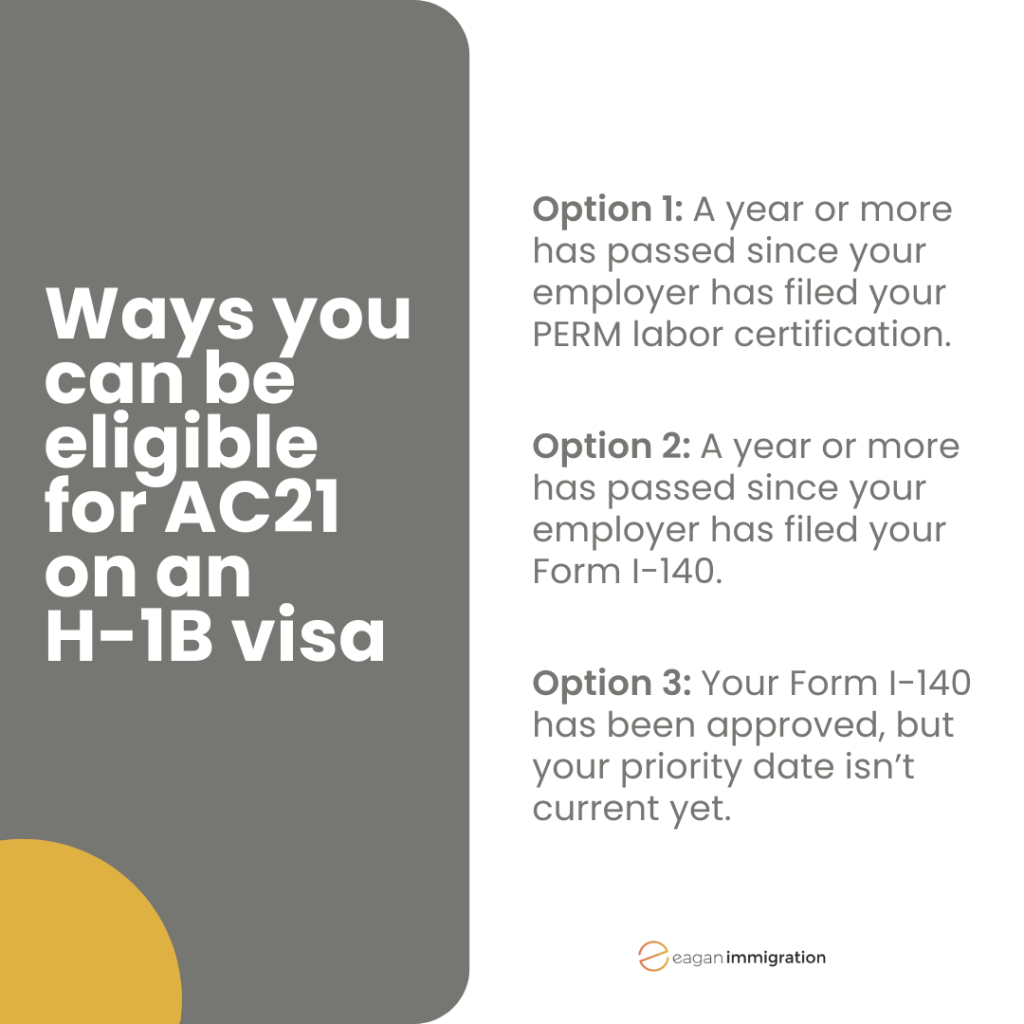Extend Your H-1B Visa and Get Your Green Card: Here’s How
- Business Immigration
- News
By Natalie McQuilkin
The H-1B visa is a temporary nonimmigrant visa that allows foreign nationals to work in specialty occupations in the United States. A major draw for foreign nationals applying for the H-1B visa is that it’s a dual-intent visa, meaning you can live and work in the U.S. temporarily, or you can apply for a green card while on the visa. Because of this, the H-1B is a great choice if you want to gain work experience in the U.S. or if you hope to one day adjust your status and become a permanent resident.
Upon receiving the H-1B visa, you’re allowed to work in the U.S. for a stint of three years initially. After that, your employer can apply for a one-year extension until you reach the visa’s six-year limit. Then, you must “either switch to another visa category, leave the U.S. for at least one year before reapplying for a new H-1B visa, or pursue a green card to continue their stay and employment in the U.S.,” an article from Docketwise Immigration Software explains.
For those who want to apply for permanent residency in the U.S., the six-year duration of the H-1B visa might seem like plenty of time to apply for and receive a green card. However, if you’re from a country with huge backlog of green card applications, like India or China, it can take years for USCIS to process these applications. As of July 2024, USCIS is just now processing employment-based visa applications for Indian nationals from 2012, as you can see in the chart below. This means it will be several years before they begin processing applications submitted in 2024.

Aside from backlogs, the process of finding an employer who will sponsor you for an employment-based immigrant visa and your adjustment of status petition can take years.
So, what can you do if you are nearing your six-year maximum and are still waiting for your green card approval?
In this blog post, we’re going to discuss the American Competitiveness in the 21st Century Act of 2000, more commonly known as AC21, which allows those with the H-1B visa to work past the six-year maximum and change jobs while waiting to receive permanent residency.
What is AC21?
AC21 was created in October 2000 with hopes of encouraging more H-1B workers to come to the U.S., as there was a shortage of skilled workers in the country at the time. Essentially, AC21 allows you as an H-1B worker to get an extension on your visa so you can continue working while you wait to receive your green card. This promotes job stability and minimizes gaps in your employment while also ensuring you maintain legal status while you’re in the United States.
Preliminary Requirements for AC21
Before you can consider AC21, you must be awaiting approval for your green card. This means you need a pending application to adjust status with an employer who has agreed to sponsor you for one.
The first step in this process is becoming a beneficiary of an immigrant work visa. The H-1B visa is a nonimmigrant visa, so it does not provide a pathway to residency on its own. Instead, you’ll have to find an employer to sponsor you for a first-, second-, or third-preference employment-based immigrant visa.
The first-preference employment-based visa, or EB-1, is for outstanding professors and researchers or certain multinational managers or executives. Along with those positions, it accommodates those with extraordinary ability, such as those who have received a Pulitzer Prize or an Oscar, as we explain in this post. The EB-2, the second-preference employment-based visa, is designed for those with an advanced degree or exceptional ability. This can include engineers, medical professionals, business executives, artists, professors, scientists, and more. Finally, EB-3, the third-preference employment-based visa, is for professionals, skilled workers, and other workers – or those who do not have job experience. Common jobs for professionals and skilled workers include healthcare professionals, engineers, teachers, and informational technology specialists. “Other worker” jobs include housekeepers, janitors, factory workers, construction workers, and more.
The first step in applying for these employment-based visas is finding an employer who is willing to hire you, and then having that employer file a Form I-140, or the Immigrant Petition for Alien Worker. Your employer will also file a Department of Labor-approved PERM labor certification, which we discuss in this blog post, along with the Form I-485, Application to Register Permanent Residence or Adjust Status. Once these steps are complete, you’ve already crossed off USCIS’ first two requirements for AC21 eligibility:
- You are a beneficiary of an approved Form I-140 (Immigrant Petition for Alien Worker), or your Form I-140 petition is pending and awaiting approval
- The Form I-140 petition is filed for EB-1, EB-2, or EB-3 employment-based visas

AC21 Eligibility Requirements for Extension
According to Temple University, you can be eligible to maintain your H-1B status beyond the six-year H-1B visa maximum if you fall under one of the three following categories:
- A year or more has passed since your employer has filed an application for a labor certification so you can obtain status as an employment-based immigrant
- A year or more has passed since your employer has filed Form I-140 for you as an employment-based immigrant
- Your Form I-140 has been approved, but your priority date to adjust your status isn’t current yet

AC21 permits a one- or three-year extension for your H-1B visa. To be eligible for a one-year extension, your PERM labor certification or Form I-140 must be submitted at least a year before your H-1B visa expires. If your Form I-140 has been approved, but your priority date isn’t current due to backlogs, you can be eligible for a three-year extension. If neither of these extensions provides enough time for you to remain in the United States while you wait to receive your green card, you can apply for another one-year extension so long as your labor certification or Form I-140 has been.
Interested In Extending Your H-1B Visa?
If you have an H-1B visa and are hoping to one day obtain permanent status in the United States, it’s best to be proactive about your future now. This is especially true if you’re nearing the end of your H-1B visa, or if you’re from countries like China or India, which have hefty backlogs to get through before 2024 priority dates become current. Missing the deadline can have a huge impact on your life. You might have to pursue a different visa to remain in the United States, or you might have to return to your home country for a year before applying for the H-1B visa again.
Using AC21 for the H-1B visa requires a lot of planning. Not only will you have to find an employer willing to sponsor you and file an adjustment of status petition on your behalf, but you’ll have to time everything right so you will be eligible for an extension.
Here at Eagan Immigration, we are here to guide you through each step of the process and answer all of your questions. If you’re interested in extending your H-1B visa so you can continue working and living in the U.S. while your green card is processed, contact us today by calling our office at (202) 709-6439 or visiting this link.
References
Visa Bulletin for July 2024, U.S. Department of State – Bureau of Consular Affairs, (Jun. 5, 2024), Visa Bulletin For July 2024 (state.gov), (last visited: Jul. 5, 2024).
Frank Gogol, Guide to AC21 and Green Cards in the U.S., Stilt, (Apr. 2024), COMPLETE guide to AC21 and green cards in the U.S. [2024] (stilt.com).
Frank Gogol, H-1B Visa to a Green Card Process Explained, Stilt, (Apr. 12, 2024), H-1B Visa to a Green Card Process Explained [2024] (stilt.com)
Policy Manual: Chapter 5 – Job Portability after Adjustment Filing and Other AC21 Provisions, USCIS, Chapter 5 – Job Portability after Adjustment Filing and Other AC21 Provisions | USCIS, (last visited: Jul. 8, 2024).
Employment-Based Immigration: First Preference EB-1, USCIS, Employment-Based Immigration: First Preference EB-1 | USCIS, (last visited: Jul. 5, 2024).
Special H-1B Status Beyond Six Years, Temple University: International Student and Scholar Services, Special H-1B Status Beyond Six Years | Temple University International Student and Scholar Services, (last visited: Jul. 5, 2024).
James Pittman, Extending H-1B Visa Status Beyond Six Years with AC21, Docketwise Immigration Software, (Jun. 24, 2024), Extending H-1B Visa Status Beyond Six Years With AC21 – Docketwise Immigration Software.


